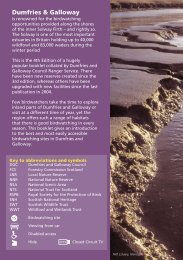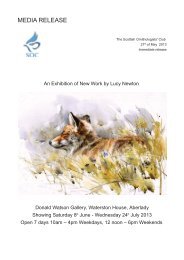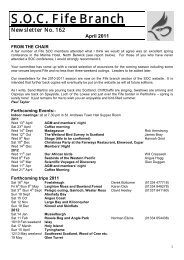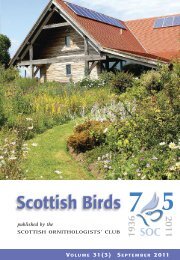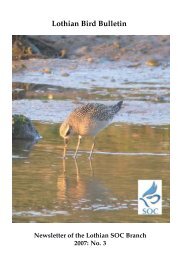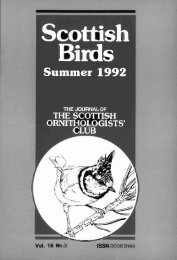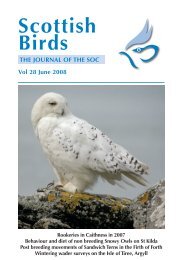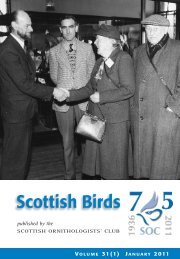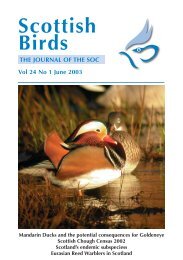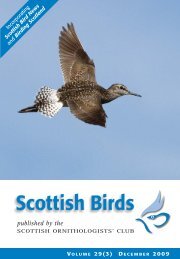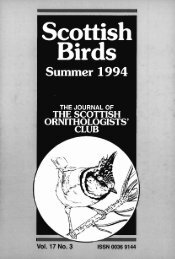V 14 No.4 - The Scottish Ornithologists' Club
V 14 No.4 - The Scottish Ornithologists' Club
V 14 No.4 - The Scottish Ornithologists' Club
Create successful ePaper yourself
Turn your PDF publications into a flip-book with our unique Google optimized e-Paper software.
1987<br />
Short Notes 211<br />
was within a few metres of it, when it flew<br />
a short distance away from the road.<br />
At 12.30, when returning along the<br />
road, I saw an immature hen Sparrowhawk,<br />
probably the same individual, feeding on the<br />
remains of the carcass, where it stayed until<br />
flushed at 12.45. by this time the carcass<br />
was much smaller and entrails were spread<br />
a little distance away. <strong>The</strong> Sparrow hawk<br />
again abandoned the carcass only when I<br />
was at close range, and flew to a nearby<br />
fence post after a first false take off. <strong>The</strong>re<br />
was no sign of a bird near the remains at<br />
13.00 but the following afternoon a hen<br />
Sparrowhawk in flight was seen nearby.<br />
After heavy rain the previous afternoon<br />
and night, the day of the observation started<br />
misty. A combination of inexperience and<br />
low prey availability because of poor<br />
weather could have made the Sparrowhawk<br />
unusually hungry.<br />
Pigeon and quail carcasses, but not<br />
rats, placed on plucking posts in the prelaying<br />
and laying periods have been taken<br />
by Sparrowhawks, Newton and Marquiss<br />
(1981). Poisoned baits, freshly killed Song<br />
Thrushes Turdus philomelos and Meadow<br />
Pipits Anthus pratensis similarly placed in<br />
the breeding season have illegally killed<br />
Sparrowhawks in Scotland (anon. verbal<br />
report, pers. comm. J. Young). In late<br />
winter a hen Sparrowhawk has been found<br />
dead beside a poisoned pigeon (pers. comm.<br />
B. Etheridge). <strong>The</strong>re seems to be no<br />
previous record of Sparrow hawks taking<br />
mammalian carrion.<br />
<strong>The</strong> possibility that some Sparrow<br />
hawks obtain significant feeding from<br />
road casualties at critical times is of interest.<br />
If such scavenging is often of prey readily<br />
carried away without trace, such as small<br />
passerines, it would be easy to overlook, and<br />
consquently underestimate, some kinds of<br />
wildlife road casualties.<br />
Acknowledgements<br />
I thank B. Etheridge, J . Young and M. Marquiss<br />
for comments and information.<br />
References<br />
Newton, I. and Marquiss, M. 1981. Effect of<br />
additional food on laying dates and clutch<br />
sizes of sparrow hawks. Ornis Scand. 12:<br />
224-229.<br />
A.M. Jones, Museo Nacional de Ciencias Naturales, 28006 Madrid, Spain<br />
& Dept. of Zoology, University of Aberdeen.<br />
A probable hybrid DunlinlSanderling<br />
On 17 May 1981 a group of ringers from<br />
the North Solway and Lothian Ringing<br />
Groups made a cannon net catch at Waterfoot<br />
on the north shore of the Solway Firth.<br />
<strong>The</strong> catch consisted of 180 Dunlin Calidris<br />
alpina and Ringed Plovers Charadrius<br />
hiaticula on spring passage to Iceland and<br />
Greenland, and amongst them was one<br />
unusual wader. <strong>The</strong> bird was in full summer<br />
plumage and had the look of a Dunlin<br />
except that it had a completely white belly<br />
and the scapulars resembled those of a<br />
Sander ling Calidris alba rather than a<br />
Dunlin. Unfortunately a full description of<br />
the bird was not taken in the field. <strong>The</strong><br />
following description is based on five<br />
photographs of the bird.<br />
Head resembling a schinzii or arctica<br />
Dunlin with distinctive buff ear coverts and<br />
dark lores and only a faint supercilium.<br />
Crown rufous, extensively streaked with<br />
black. Nape like the crown but duller. Mantle<br />
and scapulars similar to Sanderling, each<br />
feather being black with a rufous patch on<br />
either side and a white/grey tip. Tertials and<br />
wing coverts all in winter plumage,<br />
dun/grey coloured and heavily worn. Lesser<br />
coverts near the carpal joint darker, giving<br />
a dark 'shoulder patch'. Rump - not seen;<br />
upper tail coverts dark in the centre with



